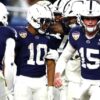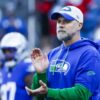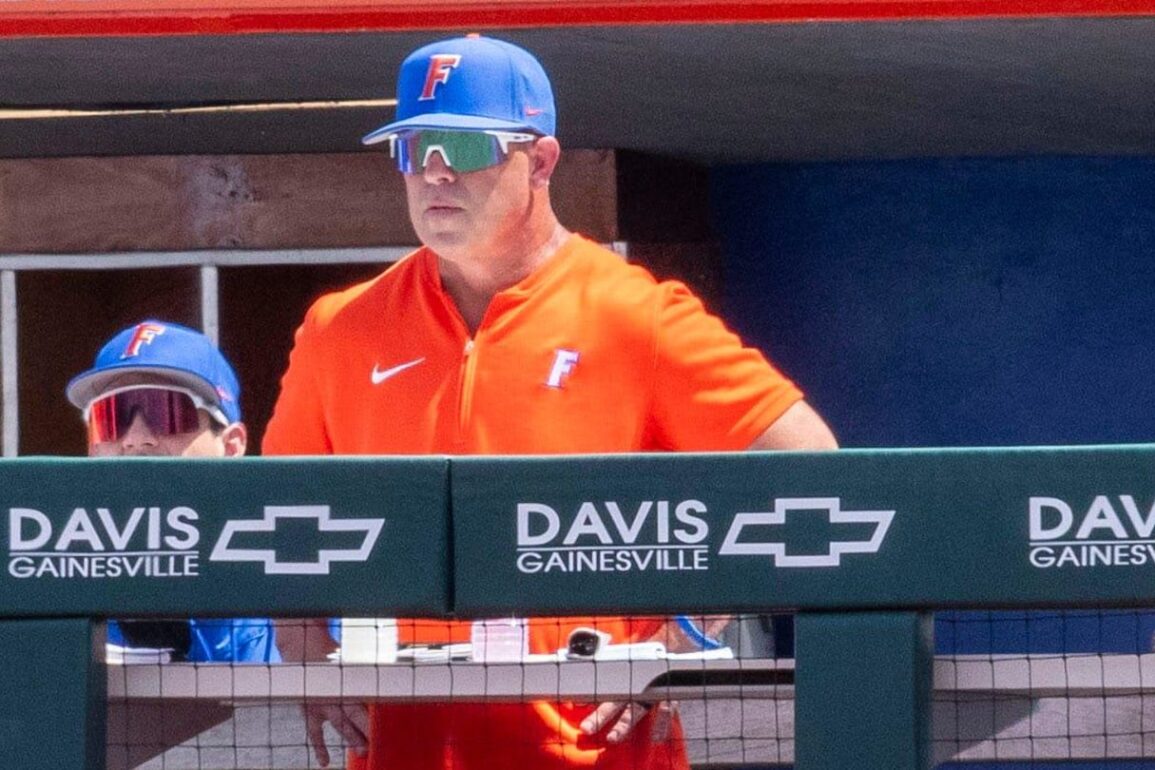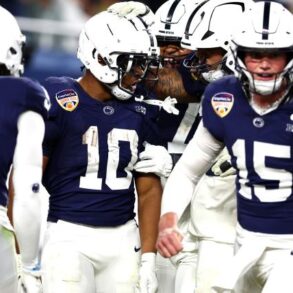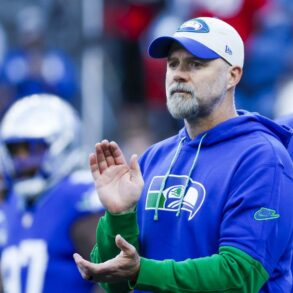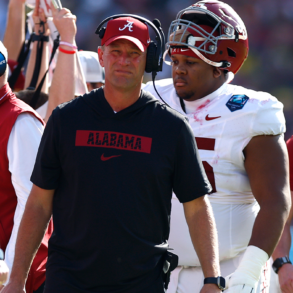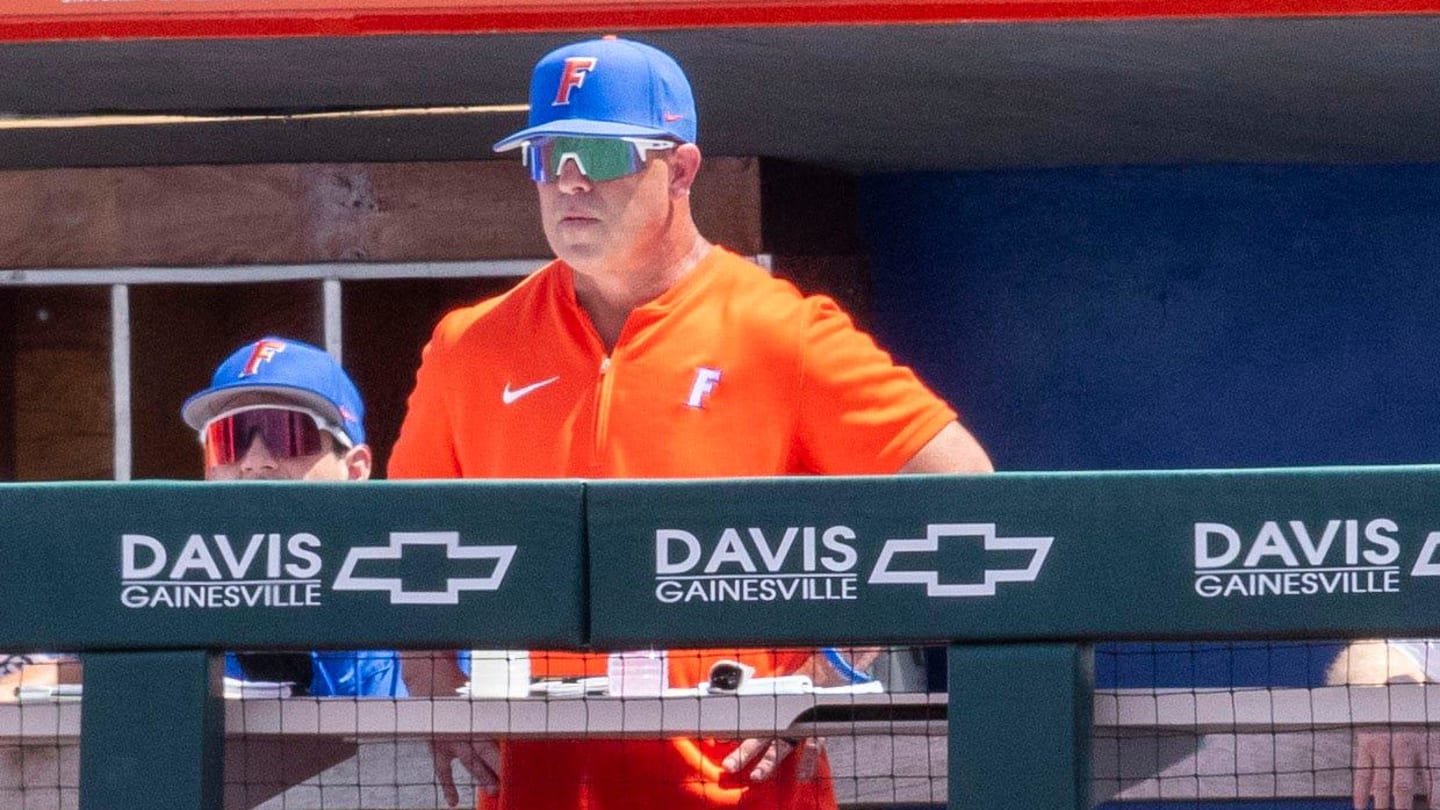
With another incredible college football season at its end, millions of fans across the country are now free to discover the world of college baseball. The race to Omaha at Condron Family Ballpark is one all Florida Gators fans can enjoy.
Regardless of your knowledge of the sport, the players or the stats, getting into college baseball is quite easy: Cheer like you’re in the stands of Ben Hill Griffin Stadium, but this time only after strikeouts, home runs or coaching ejections.
If that isn’t enough advice, here is a Gators baseball guide for Gators football fans.
Florida Baseball is one of the top programs in the nation. They just recently came in at No.three in D1Baseball’s top 100 programs, and have been projected to be one of the 10 best teams in the country this year once again.
In the past five seasons, they have a .631 win percentage under head coach Kevin O’Sullivan and have made it to Charles Schwab Field in Omaha, the home of baseball’s version of the college football playoffs, two years in a row.
The team is stacked with talent, led by a head coach Florida fans could only hope Billy Napier can become and ready to make another run at a championship appearance, a game they lost two seasons ago and finished just one game short of last summer.
The standard for the program is similar to that of the Urban Meyer years of Florida football: win and win a lot.
Head Coach Kevin O’Sullivan
Kevin “Sully’ O’Sullivan is one of the most successful head coaches in college baseball history. In 17 years at Florida, he holds a win percentage of .673, has nine College World Series appearances, six SEC championships and one national title. So far, he has taken the Gators to a school-record 16 straight NCAA tournament appearances, which ranks second nationally, as well as making it to Omaha nine times since 2010- By far the most in the nation. Since taking over at Florida, he has been the main reason for the Gators’ strong and consistent success.
Though not set in stone just yet, Florida’s projected starting lineup is almost fully made up of established players. One through Nine, the team has one of the strongest groups in the nation. Below is a look at the projected lineup as well as a Gators football comparison.
1. Catcher Luke Heyman (Junior)
Last season, Heyman hit .246 with an .823 OPS and 16 home runs. His numbers saw a drop from his freshman year in most categories, but he saw an uptick in power and run production. He has a strong arm and solid defense behind the plate and is expected to be an anchor of the defense in 2025. If he can find a middle ground between his freshman and sophomore production, he will likely be one of the more valuable all-around players for Florida.
Comparison, Jordan Castell: Castell and Heyman both burst onto the scene as freshmen, earning freshman all-SEC honors, yet hit a similar ‘sophomore slump.’ Both are very valuable players to their team but feel a little under-appreciated due to the drop-off after strong first years.
2. First Baseman Brendan Lawson (Freshman)
Lawson is the only freshman projected to start in the field for the Gators. Though new to the first base position, the Gators are prioritizing putting his bat in the lineup. MLB Pipeline rated Lawson’s bat at a 55 in his prospect profile, meaning it is expected to be above average at the MLB level. As well, during his time at Perfect Game’s showcase, his max barrel speed ranked in the 90% percentile. He hit .344 in the MLB Draft League, with more walks than strikeouts in 45 plate appearances. While he may struggle to learn the new position, his bat is expected to make it worth the bumps. Florida expects the Canadian prospect to be a big part of their future in the infield.
Comparison, Dallas Wilson: Both Wilson and Lawson are top-100 recruits with high expectations and potential expected to make an early impact with the program. They both have great size and come in as well-rounded players already. To make this comp stronger, they are both listed at 6-foot-3 and 195 pounds out of high school.
3. Second Baseman Cade Kurland (Junior)
Similar to Heyman, Kurland saw a drop in production from freshman to sophomore year. While dealing with a lingering injury last season, he hit .245 with an .803 OPS and 14 home runs. His defense was much improved on the year and at times he was one of the best Gators players. Now fully healthy, Kurland is expected to bounce back into a high-impact player in the Gators lineup.
Comparison, Kelby Collins: Both Kurland and Collins were key pieces to the program in their first and second seasons, but haven’t necessarily reached their high expectations after year one. Kurland is a hard player to comp due to the lingering injury, but If he can find the bat we saw in year one, Eugene Wilson may be the better comparison as a star player and key contributor for the Gators who simply had a rough year due to injury.
4. Third Baseman Bobby Boser (Senior)
Boser comes over from USF with a long history of production. In three years with the Bulls, he hit 31 home runs, which ranked eighth all-time in USF history. Last year, he hit .299 with a 1.018 OPS with 12 home runs. Though he may not be the star of the team, he will bring strong power and defense at the hot corner.
Comparison, Chimere Dike: Like senior transfer receiver Chimere Dike, Boser is a somewhat underrated portal addition this year. Boser could be a key addition to the offense and, like Dike, shock many with how important he becomes to the Gators’ success despite the lack of hype around his commitment compared to others.
5. Shortstop Colby Shelton (Junior)
As a freshman, Shelton was one of the best young players in the country at Alabama, yet after transferring he took a step back in year two. He hit .254 with a .925 OPS and 20 home runs last season. Despite less production, Shelton finished second on the team in home runs, RBIs and walks. He is a strong defender who will likely be a top bat for the Gators this year.
Comparison, Jake Slaughter: Colby Shelton is the engine that Florida’s offense will run on this season. Like the Gators’ All-American center Jake Slaughter, Shelton plays one of the most important positions on the team and is one of the best players. Also like Slaughter, Shelton passed up going pro to return to Florida in hopes of making a playoff push.
6. Left Fielder Blake Cyr (Junior)
Coming over from Miami, Cyr likely has the most star potential in Florida’s lineup. As a Hurricane, Cyr hit .305 with a 1.047 OPS and 17 home runs as a freshman. His second year, an injury ended his season after starting strong with a .933 OPS and seven home runs in 95 at-bats. He is expected to hit at the top of the lineup for the Gators, play strong defense in his second season in the outfield and could be the gem of Florida’s order.
Comparison, Eugene Wilson: Both Cyr and Wilson earned freshman All-American honors, quickly becoming some of the most exciting players in college. Then, injury-riddled year twos pushed them out of the spotlight. Both are exciting young players who can be some of the best in their respective college games, both were top recruits and both are expected to be huge factors in the Gators’ success in their upcoming seasons.
7. Center Fielder Kyle Jones (Sophomore)
As a freshman at Stetson, Jones was exceptional, hitting .351 with a .928 OPS and five home runs. He will bring elite speed and defense to the Gators this year after stealing 23 bases and finishing as an NCAA gold glove finalist last season. He was named ASUN freshman of the year, freshman All-ASUN and all-conference third team. After hitting leadoff a majority of last season, he seems to be the favorite to do the same at Florida. D1Baseball believes he has ‘day-one draft potential’.
Comparison, Elijhah Badger: Both exciting playmakers with a knack for highlight reel plays, Jones and Badger were both huge portal acquisitions and explosive athletes who can fill important roles early on at Florida. Both come to UF hoping to improve their draft stock. Similar to Badger leading Florida receivers in yards, Jones is expected to finish with the highest batting average on the roster.
8. Right Fielder Ty Evans (Senior)
Evans seemed to be having a breakout year for Florida before a broken wrist ended his 2024 season. In 49 games, he was hitting .316 with a .987 OPS and 13 home runs, all career-highs. This came after the 2023 College World Series where he hit five HRs in six games, becoming one of the top stories of the Gators championship push. Evans plays defense with his hair on fire and if his bat can stay what it was before injury, he will be a key component to Florida’s success at the top of their lineup.
Comparison, Devin Moore: Both Moore and Evans have extreme talent and can be top players for the program, yet neither has been able to stay healthy. Similarly, health seems to be the only thing holding them back from being one of the better players for their team. They both come into their senior years expected to play big roles coming off injury.
9. Designated Hitter Brody Donay (Junior)
Donay had his ups and downs his first season with the Gators, yet his power was exciting. He hit .246 with a .850 OPS and 14 home runs on the season while striking out 44% of his at bats. Likely to spend time at both Catcher, designated hitter and first base this season again, Donay’s versatility is a huge help for the Gators lineup. If he can manage the swing and miss, his powerful bat can be one of the best for Florida.
Comparison, Montrell Johnson: While Johnson succeeded with strong legs and powerful running, Donay did with a strong arm and a powerful bat. Comparably, Donay hit a home run in eight percent of his 2024 at-bats while Johnson scored a touchdown on six percent of his 2024 rushing attempts. Both are powerful, consistent players who may not be on any award lists at the end of seasons, but can change a game at any moment.
Florida will lean on their weekend pitching heavily during conference play, returning two of last year’s three-weekend starters. Though still to become official, below is a look at what the weekend rotation could look like, including two possible leaders for the open third spot.
1. Liam Peterson (Sophomore)
Peterson is the ace of Florida’s staff and comes into his second year as one of the best sophomores in college. He is projected to be selected early in next year’s MLB draft. In his freshman season, he finished with a 6.18 ERA, striking out 76 batters in 62.2 innings. His stuff was some of the best in the country, yet he struggled with control at times. In year two, the expectations are high, but Peterson will have to find a way to stay on the corners and out of hitter’s hot zones. If he can improve his control, he could be one of the best pitchers in all of college baseball.
Comparison, Anthony Richardson: Like former Gators quarterback Anthony Richardson, Peterson’s struggles with accuracy can overshadow his elite arm and cause him plenty of struggle. Like Richardson, he seems on his way to becoming a top draft pick but needs to show more consistency to reach his full potential and become one of the best players in the nation.
2. Pierce Coppola (Junior)
Coppola has made only nine starts in three years at Florida due to a shoulder injury his true freshman season, but when playing has shown the potential the Gators knew he had. After returning from over a year of recovery due to injury, Coppola pitched 23.2 innings in 2024, striking out 35 batters and earning a 8.75 ERA. The 6-foot-8 flamethrower has great stuff and now is expected to be fully healthy for the first time since his true freshman season. Similar to Peterson, his control can stifle his strong potential, yet if he can stay in the zone he has the ability to be an elite pitcher for Florida.
Comparison, Jason Marshall Jr: Coppola and Marshall Jr, were both top 50 recruits out of high school and expected to be instant impacts at Florida, yet that production has yet to come. Similar to Marshall, when healthy, consistency has been somewhat of a struggle. Both have had their moments when on the field, yet neither have reached the expectations they came in with.
3. Jake Clemente (Sophomore)
In Clemente’s redshirt freshman year, his late season breakout proved critical to a Florida team lacking pitching depth. Clemente finished with a 5.34 ERA in 28.2 innings while striking out 39 batters. His 12.2 strikeouts per nine innings was very impressive and one of the best for Gators relievers, helping him become one of the most reliable bullpen arms for Florida deep into the playoffs. He now seems to be the top option for the final spot in Florida’s weekend rotation after adding to his strong season with a strong summer in the Cape Cod League. In six starts in Cape Cod, he earned a 3.00 ERA and was named the East all-star starter. If he can continue his momentum, it seems as if the starting slot is his coming into 2025.
Comparison, Dijon Johnson: Clemente finished his 2024 campaign extremely strong after earning serious playing time due to lack of depth very similarly to how Johnson broke out after taking advantage of a cornerback room riddled with injury in 2024. They both came out of high school as top 200 recruits from Florida and now enter their third seasons with the program as players primed for big roles after late-season breakouts.
4. Aidan King (Freshman)
King has been a quick and surprising riser for Florida since recently getting on campus. At Bishop Snyder High school, he had a 1.64 ERA and a 15.0 strikeout-per-nine innings throughout his career, yet was still ranked the No.432 overall recruit nationally and not expected to have an instant impact. After just a few months at UF, King has become a name-to-watch. During fall, King has been consistently one of the better pitchers for Florida, even going two innings of one-hit ball during a scrimmage against USF while striking out three. If he can continue to show promise, he could push for a starting role no one saw him having a shot at early on.
Comparison, Jadan Baugh: Like Baugh, King was not one of the higher-ranked commits in his recruiting class and was not someone initially expected to have a major role in his rookie campaign. Both came to Florida as recruits ranked outside the top 300 in their class and though Baugh’s freshman year will be hard to top, King feels like a similar situation where an underrated recruit gets early playing time and has an early impact. King’s scrimmage performances remind me of Baugh’s attention-grabbing spring game as a clear sign of an emerging star fresh to campus.
When To Watch
Florida baseball will open its season with a home series against Air Force starting Feb.14 at Condron Family Ballpark. Below are a few upcoming dates of important matchups.
Florida vs Miami: three-game series starting Feb. 28 at Condron Park, Gainesville.
Florida @ UCF: March 4 in Orlando
Florida @ FSU: March 11 in Tallahassee, March 25 in Jacksonville, April 8 in Gainesville
Florida @ Tennessee: three-game series starting Mar.14 in Knoxville, Tenn.
Florida vs Georgia: three-game series starting Mar.22 at Condron Park, Gainesville.
The rest of the schedule can be found here.
With the baseball season just a few weeks out, fans can start getting excited for another race to Omaha at Condron ballpark. While it may not be Lagway throwing touchdowns or Thornton catching picks, it will be hard to find cooler moments than a struggling Michael Robertson walking off a 13-inning thriller to send the Gators to the college world series or a senior BT Riopelle hitting one into the bleachers to complete a four-run comeback in extra innings of the SEC tournament. Baseball is about the moments, and at any time, whether a Tuesday night or a Saturday, something amazing could be happening for Florida on the diamond very soon.
This post was originally published on this site be sure to check out more of their content.


